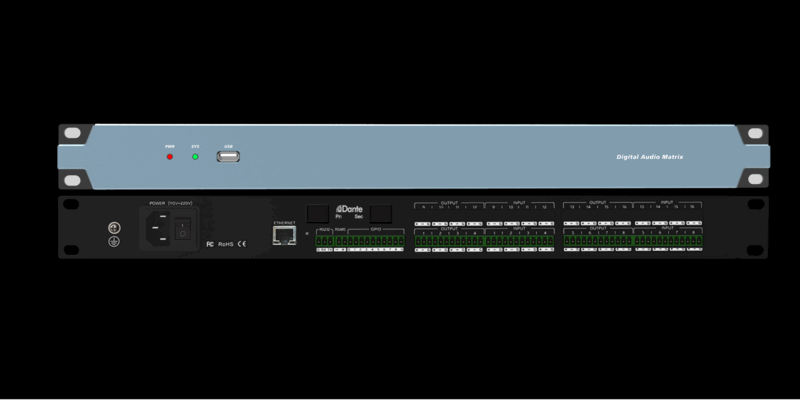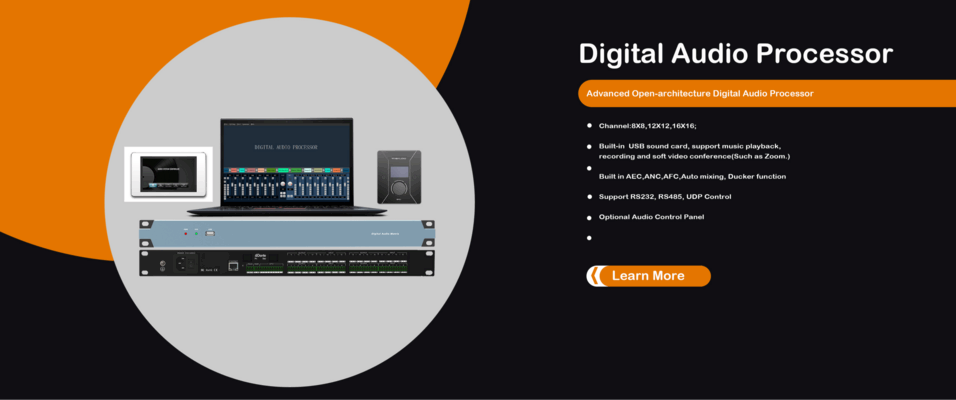In the world of professional audio, precise sound control is critical. Whether it is live events, conference rooms, home theaters or recording studios, the need for clear and pure audio with minimal distortion is paramount. This is where digital audio processing plays a transformative role. By leveraging advanced algorithms and real-time processing capabilities, digital audio technology can improve the sound quality, flexibility and performance of audio control.
1. What is digital audio processing?
Digital audio processing refers to the processing and enhancement of sound using a digital signal processor (DSP). Unlike analog processing, which directly modifies sound waves, digital processing converts sound into binary statistics, allowing for more precise control of various parameters such as equalization, compression, reverberation and noise reduction.
Modern digital processors can remove background noise, echo cancellation and feedback suppression, improve vocal clarity, and even create immersive soundscapes, making them essential in both professional and consumer audio applications.

2. Advantages of FHBAUDIO digital audio processing
1. Comprehensive matrix mixing function, 24bit/48KHz sampling frequency, high-performance A/D D/A converter and 32-bit floating-point DSP processor;
2. DSP audio processing, built-in automatic mixer, including mixing and automatic mixing functions, with mixing component control function, and feedback elimination module;
3. Input per channel: preamplifier, signal generator, expander, compressor, 5-band parametric equalizer;
4. Output per channel: 31-band graphic equalizer, delay, crossover, limiter;
5. Each channel can set the Chinese name independently;
6. Test signal generator, sine wave, pink noise, white noise, frequency and level optional;
7. Input phase switch, mute switch, phantom power switch;
8. Output mute switch and phase switch for each channel;
9. Flexible switching between Chinese, Traditional and English languages;
10. One-click display of all function modes Block;
11. Random storage of Chinese help documents and software;
12. Random generation of central control code; automatic power-off protection memory function; one-key reset function;
13. Channel copy, paste, and joint control functions;
14. The same host allows 10 users to manage, and the user name can be set to Chinese;
15. The device name can be modified, and Chinese names are allowed;
16. Editable preset mode, create, delete, modify, one-key initialization, preset mode can be stored in the computer and one-key recovery;
17. The input and output channels can set the color independently, and the switch can be restored with one key;
18. There is a camera tracking function, which can independently adjust the preset position of a camera;
19. Convenient and fast web control: built-in web controller, in It can be operated quickly on Windows, Android, iOS and other platforms;
20. Ethernet multi-purpose data transmission and control port can support real-time management of single and multiple devices;
21. Intuitive, simple and easy-to-understand graphical software control interface, bringing customers a fast and real-time operation experience;
22. The device does not need a CD, comes with installation software, one device for one software version, solves the troubles caused by the loss of installation CDs and the confusion of multiple software versions;
23. The expandable USB interface can realize the device upgrade function, USB music playback and recording function or USB sound card function, and can be directly connected to the computer USB port for video conferencing;
24. Configured with bidirectional RS232 interface, RS485 interface, standard Ethernet control interface, 8-channel programmable GPIO control interface (customizable input and output);
25. Support 8~100 groups of scene preset functions;
26. Intuitive, graphical software control interface, can work in XP/Windows7, 8, 10 and other system environments;

III. FHBAUDIO MX-0808 Applications of Digital Audio Processing
1. Professional Audio and Live Events
From live performances to corporate events, live sound engineers use it to mix and manage multiple audio sources in real time. DSP helps control sound dynamics, reduce echo, and ensure stable audio output in different speaker areas.
2. Conference Room Sound System
Clear conversations are essential in business meetings, and it ensures that conference room sound systems can provide high speech clarity. Echo cancellation, beamforming microphones, and automatic gain control add a lot to the professional meeting experience.
3. Restaurants, Hotels, and Retail Spaces
Background music in restaurants and retail spaces needs to be balanced and smoothly distributed. DSP ensures optimal volume, prevents audio distortion, and provides consistent sound coverage in specific areas.
The Future of Digital Audio Processing
With the rapid development of artificial intelligence and device mastering, digital audio processing is bound to become more complex. Future innovations will also include AI-driven on-board mixing, real-time room acoustic adjustments, and even personalized audio research for different listeners.
As the demand for excellent audio continues to grow, groups and users must adopt digital processing technology to stay ahead in the evolving audio industry.
